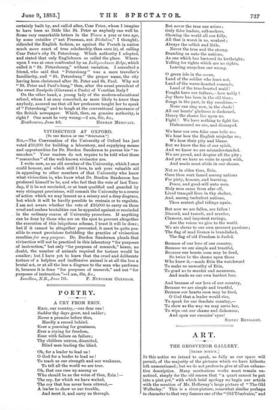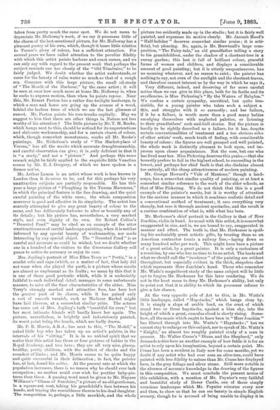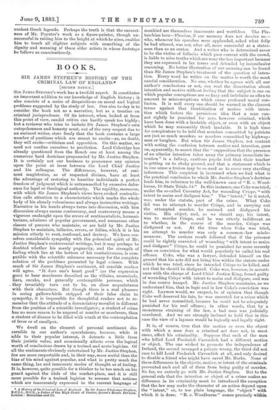THE GROSVENOR GALLERY.
[THIRD NOTICE.] IN this notice we intend to speak, as fully as our space will permit, of the majority of the pictures which we have hitherto left unmentioned; but we do not profess to give at all an exhaustive description. Many meritorious works must remain unnoticed, simply for the old reason that "a quart cannot be put into a pint pot," with which brief apology we begin our article with the mention of Mr. Holloway's large picture of "The Old Wellesley." This is a river-picture, somewhat similar perhaps in character to that very famous one of the "Old Umeraire," and taken from pretty much the same spot. We do not mean to depreciate Mr. Holloway's work, if we say it possesses little of the charm of the last-mentioned picture, for Mr. Holloway has a pleasant poetry of his own, which, though it bears little relation to Turner's glory of colour, has a sufficient attraction. For several years we have called attention to the peculiar fidelity with which this artist paints harbour and coast scenes, and we can only say with regard to the present work that perhaps the subject reminds one too closely of the "Old Temeraire," to be fairly judged. We doubt whether the artist understands, or cares for the beauty of calm water as much as that of a rough sea. Compare with this large picture, the small oil-study of "The Mouth of the Harbour," by the same artist ; it will be seen at once how mach more at home Mr. Holloway is, when he seeks to express motion, than when he paints repose. Near this, Mr. Ernest Parton has a rather fine twilight landscape, in which a man and horse are going up the avenue of a wood, behind the leafless trees of which we see the last glimmer of sunset. Mr. Parton paints his tree-trunks capitally. May we suggest to him that there are other things in Nature not less worthy of his attention ? The little picture by Mr. T. Al. Rooke, which hangs next to this, should be noticed for its unpretentious and elaborate workmanship, and for a certain charm of colour, which, though somewhat monotonous, marks all Mr. Rooke's paintings. Mr. Nicholson's study of "The Market-place of Verona," has all the merits which accurate draughtsmanship, and careful observation can give; it is .only deficient in that it is "a study," and not a "picture." And perhaps this same remark might be fairly applied to the exquisite little Venetian scenes by Mr. E. J. Gregory, of which we have spoken in a former not'ce.
Mr. Arthur Lemon is an artist whose work is less known in London than it deserves to be, and for this perhaps his very unattractive subjects are partially responsible. He has this year a large picture of "Ploughing in the Tuscan Maremma," in which the principal feature is the fine drawing, and the quiet careful painting of the white oxen ; the whole composition moreover is good and effective in its simplicity. The artist has scarcely attempted to give any great beauty of colour to the scene, and has deliberately forborne to alter or beautify any of its details ; but his picture has, nevertheless, a very marked style, and even dignity of its own. Sir Robert Collier's "Deserted Pond" may be cited as an example of the utter unattractiveness of careful landscape-painting, when it is neither informed by any special beauty of workmanship, nor made interesting by any special object. The "Deserted Pond" is as careful and accurate as could be wished, but we doubt whether one in a hundred of the visitors to the Grosvenor Gallery will pause to notice its accuracy or enjoy its care.
Mrs. Jopling's portrait of Miss Ellen Terry as "Portia," in a scarlet robe and cape (which, as a matter of fact, that lady did not wear when she played the part), is a picture whose merits are almost as unpleasant as its faults ; we mean by this that it is one of those good portraits which, while it is undeniably faithful to each individual detail, manages in some unfortunate manner, to miss all the finer characteristics of the sitter. Miss Terry's strongly marked and attractive face, has here lost the greater part of its charm, while it has gained only a sort of smooth varnish, such as Madame Rachel might have laid thereon, at a somewhat similar price. The actress has come out of Mrs. Jopling's bath "beautiful for ever," but her most intimate friends will hardly know her again. The picture, nevertheless, is brightly and industriously painted, its worst point being the hands, which are badly drawn.
Mr. P. R. Morris, A.R.A., has next to this, "The Model," a naked little boy who has taken up an artist's palette, in the intervals of his "sitting." It is in no unkind spirit that we notice that this artist has three or four pictures of babies in the Royal Academy, and two here ; they are all very nice, plump, healthy, pretty children, with the reddest of cheeks and the roundest of limbs ; and Mr. Morris seems to be quite happy and quite successful in their delineation ; in fact, the painter has, at last, found his métier. At the present rate at which the population increases, there is no reason why he should ever lack occupation ; no mother could ever wish for prettier baby-pictures than these. A passing word must be given to Mr. Haynes Williams's" Gleam of Sunshine," a picture of an old gentleman, in a square-cut coat, taking his grandchild's face between his hands, and tracing the resemblance therein to his dead daughter. The composition is, perhaps, a little mawkish, and the whole picture too evidently made up in the studio ; but it is fairly well painted, and expresses its motive clearly. Mr. Jacomb Hood's "Half-holiday" deserves somewhat similar praise ; it is artificial, but pleasing. So, again, is Mr. Brewtnall's large composition, "The Fairy-tale," an old grandfather telling a story to his grandchildren, under the shadow of a chestnut-tree in asunny garden; this last is fall of brilliant colour, graceful forms of women and children, and displays a considerable amount of good painting; but it is utterly unspontaneous, has no meaning whatever, and no reason to exist ; the painter has nothing to say, not even of the sunlight and the chestnut-leaves, and therefore cannot interest us by the way in which he says it.
Very different, indeed, and deserving of far more careful notice than we can give in this place, both for its faults and its excellencies, is Miss Pickering's "By the Waters of Babylon." We confess a certain sympathy, uncritical, but quite irresistible, for a young painter who takes such a subject a this, and struggles with it so earnestly; and her failure,. if it be a failure, is worth more than a good many babies smudging themselves with neglected palettes, or listening to their grandfathers' cock-and-bull stories. But the picture is hardly to be rightly described as a failure, for it has, despitecertain conventionalities of treatment and a too obvious echo of other artists' work, much truth of feeling, with considerable beauty of colour ; the figures are well grouped and well painted,. the whole work is distinctly pleasant to look upon, and improves upon closer acquaintance. Not the rose, but one who has lived near her. Miss Pickering deserves this praise,—that shehonestly prefers to fail in the highest school, to succeeding in the lowest, and perhaps her chief fault is that she disdains almost too entirely, all the cheap attractiveness of modern painting.
Mr. George Howard's "Vale Of Mentone," though a landscape, has a somewhat similar quality of painting, or at least a somewhat similar reference to the work of the elder schools, as that of Miss Pickering. We do not think that this is a good example of the painter's merits, but it is worthy of attention for the curious manner in which it combines realistic detail and a conventional method of treatment ; it sees everything very sharply, but sees it through ancient spectacles, and the result is a curious combination of what is, with what has been.
Mr. Herkomer's chief portrait in the Gallery is that of Herr Joachim, violin in hand. As usual with this artist, it is somewhat exaggerated in size, and is, we are bound to say, exaggerated in manner and effect. The truth is, that Mr. Herkomer is spoiling his undeniably great artistic gifts, by treating them as an American contractor treats a railway line,—laying down so many hundred miles per week. This might have been a picture of a great artist, by a great painter. It is only a caricature of a musician, by one who has no time to be an artist. The haste and what we should call the " insolence " of the painting are evident throughout, but especially evident in the thick, shapeless claw which represents Herr Joachim's hand. Those who remember Mr. Watts's magnificent study of the same subject will be little apt to forgive Mr. Herkomer for this later rendering. We do not in the least mean to deny Mr. Herkomer's ability, but only to point out that it is ability to which its possessor refuses to give a fair chance.
At the very opposite pole of Art to this, is Mr. Watts's little landscape, called "Haystacks," which hangs close by. It is simply a slope of arable land, on the crest of which stand two or three haystacks, against a blue sky, into the height of which a great, cumulus cloud is slowly rising. Somehow, all the music which ought to have been in "Herr Joachim" has filtered through into Mr. Watts's "Haystacks ;" but we cannot stay to enlarge on this subject, nor to speak of Mr. Watts's "Knight," an almost too roughly painted study of a man in armour. Mr. Walter Crane's "Diana and the Shepherd," only demands notice here as another example of how futile it is for anartist to rely upon his imagination, beyond a certain point. Mr. Cranehas been a resident in Italy now for some months, yet we doubt if any artist who had ever seen an olive-tree, could havepainted with less fidelity to nature than Mr. Crane has displayed here, in the grey foliage and silver stems. Still more notable isthe absence of accurate knowledge in the drawing of the figures in this composition. We must conclude the present notice of this exhibition, with a mention of Mr. Poynter's very faithful: and beautiful study of Dover Castle, one of those simply veracious landscapes which Mr. Poynter eiecutes every now. and then, to show us that he can see beauty in simple English. scenery, though he is accused of being unable to display Ma ancient Greek legends. Perhaps the truth is that the earnestness of Mr. Poynter's work as a figure-painter, though unsuccessful in raising him to the height at which he aims, enables him to touch all slighter subjects with something of the dignity and meaning of those elder artists in whose footsteps he follows so conscientiously.




































 Previous page
Previous page